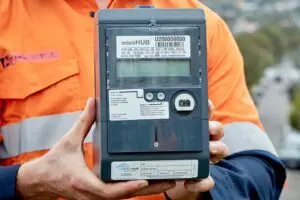Battery storage developers are warning that new attempts to impose strict new rules on the operation of big battery facilities could lift costs, and delay investment in the one sector of the green energy transition that is actually doing well.
“This is a bad proposal, and bad policy making,” wrote Joel Gilmore, the head of regulatory affairs at Iberdola Australia, the local offshoot of the Spanish energy giant that owns and/or operates several big battery projects, as well as wind and solar farms, in Australia.
The concern is over a proposal by the Australian Energy Market Operator to force big batteries to provide “primary frequency response” when charging as well as discharging, and also when they are dispatched at zero.
The upshot of this means that the batteries will be forced to keep “cycling”, which Gilmore says means a re-assessment of warranties, battery lifecycles, and the economics of individual projects.
Primary frequency response is one of the key system services traditionally supplied by synchronous generators and spinning machines such as coal and gas generators. AEMO says it is seeking to make sure that these PFR services are still delivered as the system transitions to wind, solar and battery inverters.
But the battery industry says the AEMO proposal is simply a rehash of rule changes that have already been twice rejected by the industry, and by the official rule-maker, the Australian Energy Market Commission.
Gilmore wrote on LInkedIn that this will create more regulatory and market uncertainty for batteries and risks further delaying the clean energy transition.
“AEMO is again trying to put new costs on batteries – requiring them to cycle even when dispatched at zero,” Gilmore wrote. He says this will chew up warranted cycles, and “increase the cost of batteries and delay investment”, and will force storage developers to rethink their business plans.
Battery storage projects are relatively new to the grid, with the first major one installed in South Australia in late 2017, at Hornsdale Power Reserve.
Many of these projects have depended on contracts or direct government support, often to test one of the many different service that battery storage can deliver, in some cases so-called grid forming inverters, or to address specific frequency issues or improve network capacity.
Only recently have battery storage projects got to the point where the costs and market opportunities mean some batteries can be independently financed and operate in the open market. The new rule proposals by AEMO are seen as a new and unexpected stumbling block.
The new battle over PFR is just one of many being fought among institutions, developers, engineers and investors over the management of the grid as it makes its rapid and dramatic switch from fossil fuels to renewables, and adopts new operating protocols and seeks new market signals.
Gilmore and others expressed concern that the AEMC was even entertaining the rule change, given that the issue had been discussed – and in many minds resolved – over the past four years, and because the AEMC admits itself it will increase costs.
“The Commission recognises that these proposed changes go beyond the existing obligation for scheduled and semi-scheduled generators to provide PFR when generating and are likely to impose material costs for batteries operating in the NEM,” the AEMC says in its consultation document.
“We are interested in stakeholder views on the materiality of these costs for batteries that are charging from the grid or providing contingency or regulation FCAS,” it adds.
Gilmore’s proposed solution is that, if AEMO is still concerned about PFR, then it should establish a new FCAS market for PFR, in the same way as it has for fast frequency response – and in the past for other frequency markets.
He says an incentive does exist in the form of a new “double sided causer pays” framework that relates to equipment, like batteries, that import and export from the grid.
That framework was designed by AEMO, but it now appears to concede that this won’t deliver enough PFR and it wants to make it mandatory at all times. Gilmore says constant cycling could chew up a sizeable part of the battery capacity that cannot be used in other markets.
“We shouldn’t have to re-prosecute arguments every 12 months and AEMO shouldn’t try to be a market design body (see also: day ahead markets),” Gilmore wrote on LinkedIn.
“It also highlights the problem with just naively mandating “everything” and assuming this solves the problem, instead of doing the hard analysis.”
He notes that the AEMC itself declared just last October hat generators which are not dispatched in the energy market to generate electricity “are not required to operate in a frequency response mode”
Gilmore’s other concern is that this new proposal will result in delays to other key reforms, such as the connections protocol, standards for “grid forming batteries” that will provide yet more essential services, and other resources that will be needed for a 100 per cent renewable grid.
Christiaan Zuur, the head of policy at the Clean Energy Council, said that providing PFR meant making small adjustments to the power output of a battery to help moderate small changes in power system frequency.
“Currently, battery providers only need to provide this response when they are already active in the energy market, but not in other situations,” he said.
“AEMO’s rule change would significantly expand this obligation to require batteries to also provide a response for when the battery is enabled to provide what are known as frequency control ancillary services (FCAS).
“This translates to a significant increase in the amount of time a battery would be making these small adjustments to its power output. Cumulatively, these small adjustments can have major cost implications for batteries, mainly by increasing the wear and tear on the battery and affecting its warranty.
“Right now, we need more batteries in the system to support reliability of supply and help protect against major disturbances.
“Our members tell us it’s already hard enough to get battery projects over the line, given the technical complexities of connection as well as broader supply chain issues that make it hard to source batteries. Imposing additional costs is precisely the wrong move at this juncture.
“The AEMC has previously ruled against this requirement to require batteries to provide PFR when they are not providing energy. We hope AEMC continues to recognise the broader issues described above and rejects this request from AEMO.”
Updated: In a later statement emailed to RenewEconomy, AEMO’s Violette Mouchaileh noted that while grid-scale battery capacity is slightly greater that 1 gigawatt (GW), it accounts for approximately 20 per cent of proposed projects in the National Electricity Market.
“The growing number and scale of grid-scale batteries will contribute to maintaining good frequency control via the provision of Primary Frequency Response (PFR), which would increasingly be important with the retirement of large thermal generating units.
“This will work together with new arrangement to support market-based incentives via the frequency performance payment rule change.
“AEMO’s rule change proposal seeks to firstly correct the un-intended exclusion of Integrated Resources providers (such a storage systems) from the need to comply with PFR, which occurred through the Integrating Energy Storage System rule change.
“Secondly, and given the bi-directional nature of grid-scale batteries, the rule change seeks to put in place an obligation on grid-scale batteries to provide PFR ONLY when operating commercially. That is, in periods when the unit is dispatched for charging or discharging energy at a level other than zero, or enabled for a market ancillary service.
“In other words, the battery’s offer needs to be cleared in any of the energy or market ancillary services for the obligation to apply.
“AEMO’s proposal questions whether relief from complying with PFR should be allowed for batteries that are only enabled for FCAS. The AEMC consultation process will decide this important policy issue in due course. And we look forward to engaging with the AEMC and stakeholders to work through these issues.”









